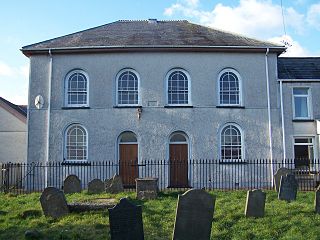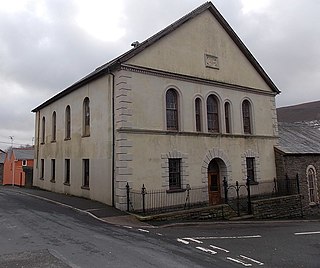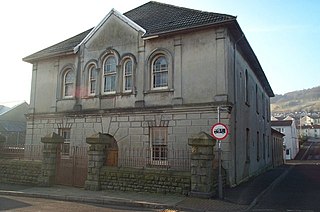
Bethania was a Calvinistic Methodist chapel in Aberdare, Rhondda Cynon Taf, Wales, which seated 550 people. Located near the centre of Aberdare, it had a somewhat concealed entrance and was approached up a long flight of steps.

Calfaria Baptist Chapel, Aberdare, was one of the largest baptist churches in the South Wales Valleys and the oldest in the Aberdare valley. The chapel had an ornate interior, including a boarded ceiling with a deeply undercut rose, while the balcony balustrading had a cast iron front with an intricate foliage design. These features were common in the Welsh chapels of the late nineteenth century. The organ was installed in 1903 at a cost of £850. It was played for the last time in 2012 by Robert Nicholls, during a Radio Cymru broadcast shortly before the closure of the chapel.
Gwawr, Aberaman was a Baptist chapel in Regent Street, Aberaman, near Aberdare, South Wales, formed as a branch of Calfaria, Aberdare
Ebenezer, Trecynon is an Independent (Congregationalist) chapel in Ebenezer Street, Trecynon, Aberdare, Wales. It was one of the earliest Independent chapels in the Cynon Valley and remained an active place of worship until 2009.
Horeb, Llwydcoed is an Independent (Congregationalist) chapel in Llwydcoed, Aberdare, Wales.

Nebo, Hirwaun was an Independent (Congregationalist) chapel in Merthyr Road, Hirwaun, Aberdare, Wales.

Elim, Cwmdare was an Independent (Congregationalist) chapel in Cwmdare, Aberdare, Wales.

Salem, Robertstown is an Independent (Congregationalist) chapel in Bridge Street, Robertstown, Aberdare, Wales.
Bethel, Gadlys was an Independent (Congregationalist) chapel in Railway Street, Gadlys, Aberdare, Wales.
Tabernacle, Abercynon was a Calvinistic Methodist chapel in Edward Street, Abercynon, Mid Glamorgan, Wales. Services at Tabernacle were conducted in the Welsh language.
Carmel, Penrhiwceiber is an Independent chapel in Penrhiwceiber, Glamorgan, Wales. Services at Carmel were conducted in the Welsh language.
Hermon, Penrhiwceiber was a Calvinistic Methodist chapel in Railway Terrace, Penrhiwceiber, Glamorgan, Wales. Services at Hermon were conducted in the Welsh language.
Bethel, Miskin was an Independent chapel in Glyngwyn Street, Miskin, Mountain Ash, Glamorgan, Wales. Services at Bethel were conducted in the Welsh language.

Bethania, Mountain Ash is an Independent chapel in Phillip Street, Mountain Ash, Glamorgan, Wales. Services at Bethania are conducted in the Welsh language.
Bethlehem, Mountain Ash was a Calvinistic Methodist chapel in Pryce Street, Mountain Ash, Glamorgan, Wales. Services at Bethlehem were conducted in the Welsh language.
Moriah Aman, Cwmaman was a Welsh Independent (Congregationalist) chapel in Fforchaman Road, Cwmaman, Rhondda Cynon Taf, Wales.
Siloh, Trecynon was an Independent (Congregationalist) chapel in Mount Pleasant, Trecynon, Aberdare, Wales.

Bethesda, Abercwmboi is a Welsh Baptist church in Abercwmboi near Aberdare. Services continue to be held in the Welsh language.












